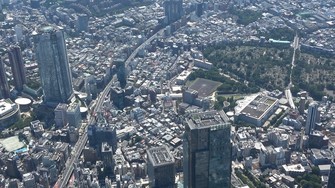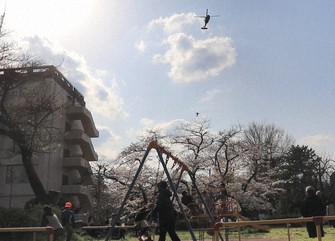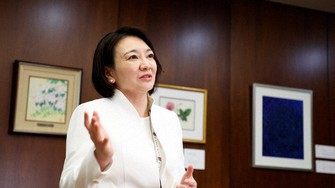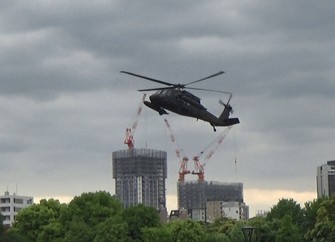
In this image captured from video, Minato Ward Mayor Ai Seike speaks on the need to remove the Akasaka Press Center U.S. military facility, in Tokyo’s Minato Ward on May 27, 2025. (Mainichi/Takahiro Kato)
TOKYO — The Akasaka Press Center in Tokyo’s Roppongi district is one of a number of locations that have been used by U.S. military forces in Japan since the end of the Pacific War in 1945. The capital’s Minato Ward, which houses the site, has long called on the Japanese government to remove it due to noise from helicopters and concerns about the possibility of accidents.
In an interview with the Mainichi Shimbun in May this year, Minato Ward Mayor Ai Seike, 50, noted changes in the surrounding environment, such as the increase in high-rise buildings and flight congestion resulting from the new Haneda flight routes. “There are structural dangers and I want to continue to seek its removal. The mayor has a responsibility to protect the safety of the ward and the lives of its residents,” she emphasized.
Facility located in heart of Roppongi’s entertainment district

A U.S. military heliport, center, is pictured in Tokyo’s Roppongi district, surrounded by many high-rise buildings, in this photo taken from a Mainichi Shimbun helicopter on July 12, 2023. (Mainichi)
Seike was born and raised in Minato Ward and after working as a newspaper reporter, served as a ward councilor for 13 years before being elected as mayor in June last year.
As for why she is asking for the removal of the facility, she said, “The center, equipped with a heliport, is located in the heart of Roppongi’s entertainment district, where high-rise buildings like Roppongi Hills stand and where people from all over Japan and the world gather. The rising height of buildings in the surrounding area is making the situation increasingly dangerous.”
Seike also cited the opening of the new Haneda flight routes in 2020, in which planes landing at Haneda Airport fly low over the city center, and the fact that U.S. military helicopters using the center now pass under these routes.

A U.S. military helicopter flies beneath a new Haneda route above Tokyo’s Omotesando intersection, on Dec. 16, 2021. (Photo by Akira Itakura)
Concerns about structural dangers
In January this year, a U.S. military helicopter collided with a passenger plane in Washington, D.C., killing 67 people. Seike noted with concern that the accident occurred at the crossing point of the two aircraft. The helicopter involved was a Black Hawk, the same type that flies to the Akasaka Press Center. “The conditions are similar to those in the airspace over Roppongi, and the risk of a collision was made real to the nearby residents of the center. Although the government has explained safety measures, there is a structural danger with U.S. military helicopters crossing paths with passenger planes. The damage from an accident would be enormous,” she said.
Flying low over children’s heads
The mayor also feels concerned that U.S. military helicopters using the center fly low over children playing in the adjacent Tokyo Metropolitan Aoyama Park. Seike herself has witnessed U.S. military helicopters flying close by with her child and remarked, “While it’s become a normal sight locally, it feels strange when viewed objectively. From a safety perspective, it would be preferable to remove the center and integrate the site into a metropolitan park.”

A formation of U.S. Black Hawk military helicopters flies low above a park where children are playing in this photo taken in the Roppongi district of Tokyo’s Minato Ward on March 30, 2025. (Mainichi/Hiroyuki Oba)
A responsibility to ensure safety
In March this year, it was announced that a U.S. Forces Japan satellite office had been set up at the Akasaka Press Center. The new department, which will coordinate with the Japanese Ministry of Defense’s Joint Operations Command, is expected to become fully operational in the future. According to the ward, residents have expressed concerns that helicopter traffic between Yokota Air Base, where the command is located, and the Akasaka Press Center may increase, heightening noise and accident risks.
Seike stressed, “I will continue to persistently call on the government to secure safety, provide information and ensure that strengthening of functions does not lead to the center’s permanence.” She added, “I fully understand that the security environment surrounding Japan is growing tougher, but the mayor has a responsibility to separate security issues and protect the safety of the ward and residents’ lives. If the mayor doesn’t properly explain the situation to the government and make an appeal, who will protect them?”
Japanese government not negotiating on relocation

In this image captured from video, Minato Ward Mayor Ai Seike speaks on the need to remove the Akasaka Press Center U.S. military facility, in Tokyo’s Minato Ward on May 27, 2025. (Mainichi/Takahiro Kato)
The land where the center is located was seized by the U.S. military immediately after the war. The heliport is primarily used by military helicopters belonging to U.S. bases in the suburbs of the capital, and the site also includes the office of the U.S. military’s semi-official newspaper, Stars and Stripes, and lodging quarters for U.S. military personnel.
The Minato Ward Assembly has requested the return of the land and sought noise countermeasures since 1967, and the ward government has also done so since 1991. Although there was a period when the Japanese government also asked the U.S. military to relocate the facility, it is currently not even negotiating with the U.S. military at this stage, stating, “The heliport is a facility that enables the rapid transportation of U.S. VIPs and others and is necessary to achieve the objectives of the Japan-U.S. Security Treaty.”
Status of Forces Agreement forms background to issue

A U.S. military Black Hawk helicopter approaches a heliport in Tokyo’s Roppongi area, in this photo from video footage captured by a Mainichi Shimbun reporting team in the capital’s Minato Ward at around 1:07 p.m. on April 25, 2023. High-rise buildings can be seen under construction nearby in the background. (Mainichi)
An investigation by the Mainichi Shimbun revealed that U.S. military helicopters using the center, such as the Black Hawk, repeatedly fly over the city center at altitudes that would be illegally low for Japanese helicopters.
The background to the Japanese government’s tacit acceptance of this is formed by the Japan-U.S. Status of Forces Agreement, which grants various privileges to U.S. military aircraft including exemptions from altitude standards under Japan’s Civil Aeronautics Act.
Seike cites the fact that Japan’s Civil Aeronautics Act is not applied to U.S. military aircraft as an additional reason for requesting the center’s removal.
(Japanese original by Hiroyuki Oba, Tokyo City News Department)


AloJapan.com